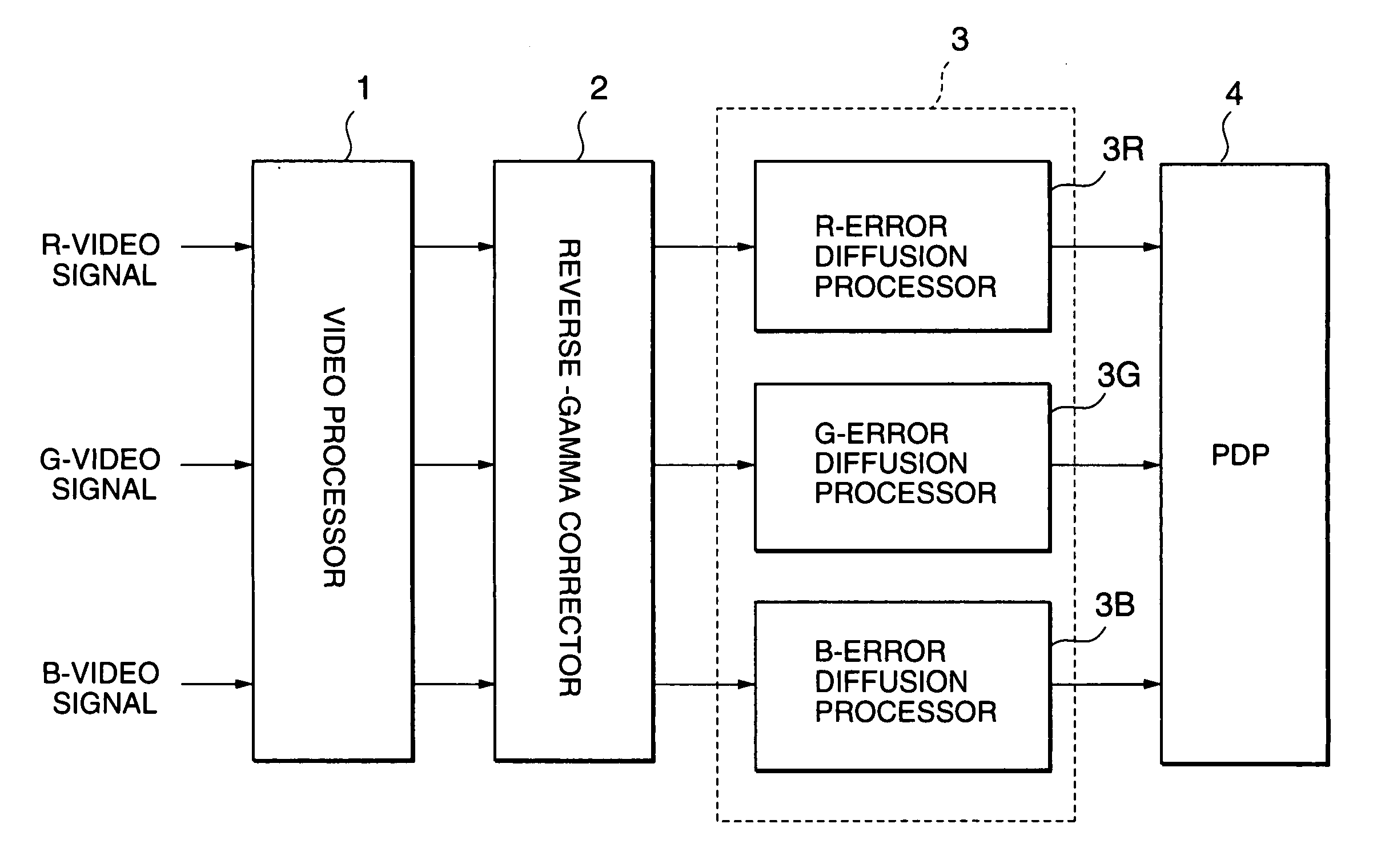Image displaying with multi-gradation processing
a multi-gradation processing and display device technology, applied in the field of image display apparatuses, can solve problems such as discontinuous gradation levels, multi-gradation processing with error diffusion, and loss of gradation
- Summary
- Abstract
- Description
- Claims
- Application Information
AI Technical Summary
Benefits of technology
Problems solved by technology
Method used
Image
Examples
first embodiment
[0119]As disclosed above, the video signal processing achieves preferable color reproduction with no color quasi edge-like image disturbances in a specific gradation range such as the low gradation range, images of color saturation as if bits have been dropped or color pattern noises by detecting a gradation level of an input video signal to adaptively depress the color saturation level in a color saturation range having a predetermined color saturation level of the input video signal only in a gradation range having a predetermined gradation level.
The Second Preferred Embodiment
[0120]The second embodiment relates to error diffusion processing. The overall circuit configuration of a displaying apparatus used for the second embodiment is like shown in FIG. 2 for the first embodiment.
[0121]Elements in this embodiments and also those in the third to the fifth embodiments which will be described later, that are the same or analogous to the elements in the first embodiment are reference...
second embodiment
[0123]As shown in FIG. 13, an R-error diffusion processor 30R, a G-error diffusion processor 30G, and a B-error diffusion processor 30B for the second embodiment have the same circuitry, the block diagrams for the processors 30G and 30B being omitted for brevity.
[0124]Error diffusion coefficients set in these processors are different from each other. However, since the operation is the same, the following disclosure is only for the R-error diffusion processor 30R, for brevity.
[0125]In FIG. 13, a 12-bit R-signal fed by the reverse-gamma corrector 2 (FIG. 2) is output via adders 31 and 32. The lower 4 bits of the 12-bit data output by the adder 32 are fed to a R-error detector 33R. The lower 4 bits correspond to the gradation difference that will be lost by converting the 12-bit digital signal (4096 gradations) to the 8-bit digital signal (256 gradations).
[0126]The R-error detector 33R generates error data by multiplying the input lower 4-bit data by error diffusion coefficients, acco...
third embodiment
[0143]The feature of the third embodiment lies in that the number of bits used for error diffusion to either of input R-, G- and B-signals, or the number of bits to be diffused to the upper 8-bits for error diffusion to either of the input signals is different from the other or all of the bits for error diffusion to the three input signals are different from each other.
[0144]The circuit configuration for the third embodiment is the same as shown in FIG. 13 for the second embodiment; hence the operation of the third embodiment will be described with reference to FIG. 13.
[0145]In FIG. 13, a 12-bit R-signal fed by the reverse-gamma corrector 2 (FIG. 2) is output via the adders 31 and 32. The lower 4 bits of the 12-bit data output by the adder 32 are fed to the R-error detector 33R. The lower 4 bits correspond to gradation difference that will be lost by converting the 12-bit digital signal (4096 gradations) to an 8-bit digital signal (256 gradations).
[0146]The R-error detector 33R gene...
PUM
 Login to View More
Login to View More Abstract
Description
Claims
Application Information
 Login to View More
Login to View More - R&D
- Intellectual Property
- Life Sciences
- Materials
- Tech Scout
- Unparalleled Data Quality
- Higher Quality Content
- 60% Fewer Hallucinations
Browse by: Latest US Patents, China's latest patents, Technical Efficacy Thesaurus, Application Domain, Technology Topic, Popular Technical Reports.
© 2025 PatSnap. All rights reserved.Legal|Privacy policy|Modern Slavery Act Transparency Statement|Sitemap|About US| Contact US: help@patsnap.com



